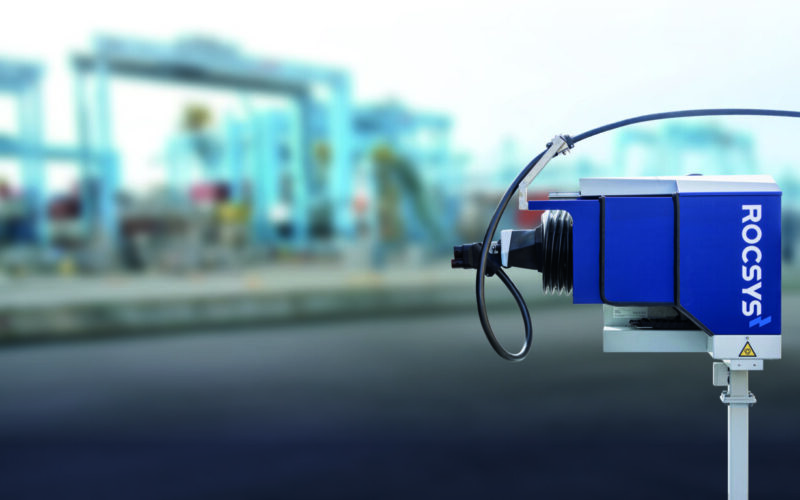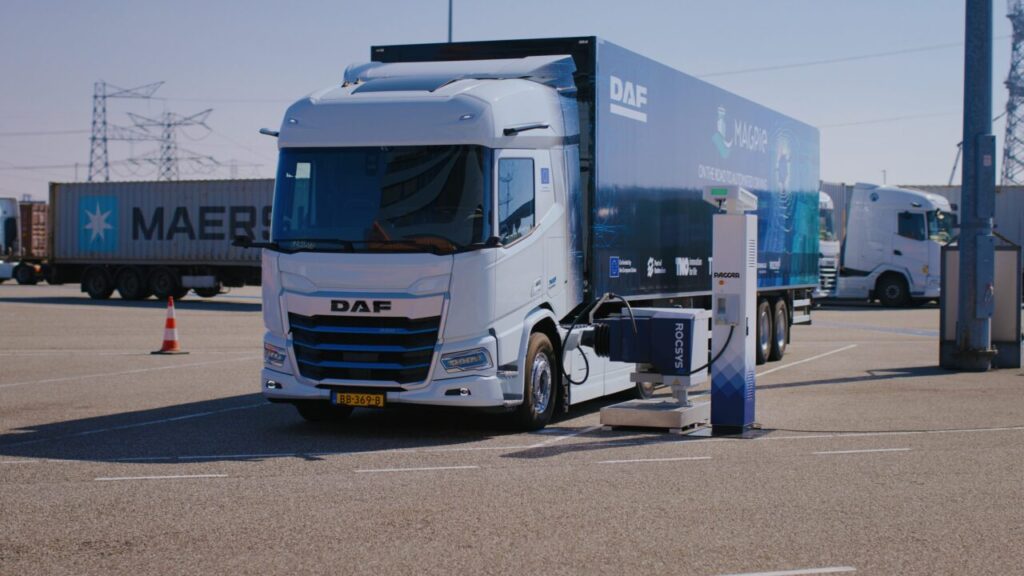Dom Magli, Reporter at Port Technology International (PTI), recently spoke with Crijn Bouman, CEO and Co-Founder of Rocsys. The conversation covered the company’s origins, its autonomous truck partnership with APM Terminals in Rotterdam, vehicle refuelling, and various collaborations over the years.
Can you share the journey of how you built Rocsys from the ground up, and what inspired your mission to completely redesign the EV charging experience?
CB: Rocsys was founded based on an experience I had in my last job. I started the company back in 2005, which made fast charging for electric vehicles.
That company in the end was acquired by a company called BB, a very large multinational, also very active in the ports industry. In my last year at a BBI in 2017, I had an experience with an autonomous driving company, and it was the first time I saw an autonomous vehicle.
That really stuck with me—they predicted that automated vehicles would eventually shape our industries and roads. That’s what inspired us.
We started building the company by asking: where does automated charging already make sense, and where are automated vehicles already in use? That led us to realise that ports and the logistics industry were the most logical place to begin.
That’s the background of Rocsys. We started in 2019, so this April marks six years since we launched the company. Since then, we’ve been very active in ports and logistics. The APM Terminals project, in particular, stands out as a real highlight. It’s currently one of the most prominent initiatives in the Port of Rotterdam, and a major development in the port industry overall.
Could you provide details on how the deployment of Rocsys’ hands-free charging platform at APM Terminals Maasvlakte II in the Port of Rotterdam is expected to enhance the efficiency and sustainability of terminal operations, particularly concerning the 30 Automated Terminal Trucks?
CB: APM Terminals is the world’s second-largest terminal operator and has a major presence in Rotterdam at the Maasvlakte terminal, which is fully automated. They’re currently expanding that terminal in a massive €1.2 billion ($1.3 billion) project.
The landside operation—from the stack to the gate—involves mixed traffic, meaning both automated and human-driven vehicles. Due to the site’s layout, using mixed traffic with autonomous vehicles allowed APMT to avoid major civil reconstruction work. As a result, they chose to deploy autonomous terminal tractors—30 in total—as part of the expansion.
The autonomous trucks are supplied by AmboTech, a Swiss company, and Rocsys will handle their charging, completely hands-free. Since the terminal and vehicles are fully automated, manual charging isn’t an option.
READ: APMT Maasvlakte II to implement shore power by 2028
This use case is a perfect fit for us. The terminal is unmanned, the vehicles are autonomous, so the charging process must also be automated. For our team, it’s a major motivator because we’re powering such a critical part of the operation.
The 30 terminal trucks move containers between the central stacking area and the rail yard, which handles over 50 per cent of the terminal’s container volume. If charging fails, operations come to a halt.
That’s why this project is so exciting—it’s one of the largest automated terminal truck deployments globally, and it’s powered by Rocsys.
Charging has often been cited as a restriction for the EV industry. Why do you think traditional refuelling models are not the solution, and what smarter approach to refuelling do electric vehicles need to overcome this challenge?
CB: One of the biggest differences is that charging a vehicle typically takes much longer than fueling. Fueling takes just a few minutes, but charging—especially for heavy port equipment—is often at least 15 to 30 minutes, and in many cases, actually around an hour.
That means you can’t use the traditional serial fuelling model, where vehicles line up and are fuelled one by one in quick, five-minute slots. Instead, you have to integrate charging into the operation itself.
In reality, the charging time for a terminal truck today is about 45 minutes to an hour. So charging needs to be decentralised—you can’t rely on a centralised fuelling point, which is the traditional model.
Therefore, charging has to be spread out across the operation—you need to charge the vehicles somewhere within their operational cycle.
That’s where automation becomes a major advantage. You can simply drop the vehicle at a designated spot, and we ensure it’s charged and ready when it’s needed again.
When charging is spread throughout the terminal, there are more people moving around and more variables involved, which increases the chances of something going wrong. Automation helps minimise that risk.
In what ways does Rocsys’ partnership with EasyMile aim to enhance the efficiency and reliability of autonomous vehicle fleets, and how does the integration of hands-free charging solutions contribute to the advancement of autonomous industrial vehicle operations?
CB: EasyMile offers an automated transport solution, and its value proposition includes reduced labour costs. But if you still need personnel just for charging, the business case weakens. To make their solution fully convincing, the operation must be completely hands-free, and that’s where we come in. Without automated charging, the autonomy promise isn’t fully realised.
We work with them because while they offer an automated transport solution, customers are looking for a fully autonomous, end-to-end operation. At the end of the day, fleet owners just want the vehicles to do their job—whether that’s transporting containers or delivering goods—and for that to happen seamlessly, hands-free charging is essential. Combining automated vehicles with hands-free charging enables a truly autonomous and effortless operation.
READ: APMT Maasvlakte II initiates mega expansion
How does Rocsys’ partnership with Aidrivers enhance the application of autonomous charging systems within AI-driven port logistics, and what role does this collaboration play in accelerating sustainability efforts in maritime operations?
CB: It’s quite similar to our partnership with Easymile. It’s all about integrating autonomous, zero-emission electric mobility into a maritime environment. This supports the decarbonisation goals of many ports and also improves operational efficiency.
When ports talk about the future, it’s usually focused on two things: cutting emissions and increasing efficiency. That’s exactly what we help enable — switching to electric vehicles for cleaner operations, and adding hands-free automation to boost overall efficiency.
What are Rocsys’ ambitions for 2025?
CB: Of course, we’re focused on successfully rolling out the APM Terminals project in Rotterdam, with the goal of having the first vehicles operational by the end of the year. We’re working hard to achieve that.
In addition, we’re very active in the logistics sector and plan to announce more updates there in the coming year. We’re also exploring the robot taxi sector.
We’ve been active in North America for over three years now, with plans to expand further in 2025. We’ve got some exciting projects coming up there, so we’re putting a specific focus on the North American market this year.

Crijn Bouman has 19 years of experience in the EV industry. He founded Epyon in 2005, starting with fast chargers for industrial vehicles before expanding to electric cars. After Epyon was acquired by ABB, he joined their EV charging group. He now works at Rocsys, focusing on automating charging connections.









